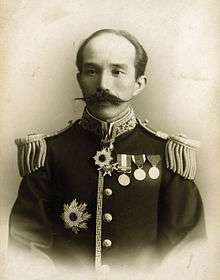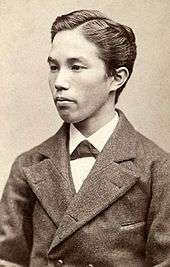Kaneko Kentarō
| Kaneko Kentarō | |
|---|---|
 Kaneko Kentarō | |
| Born |
February 4, 1853 Fukuoka, Japan |
| Died |
May 16, 1942 (aged 89) Tokyo, Japan |
| Nationality | Japan |
| Occupation | Diplomat, Cabinet Minister |
Count Kaneko Kentarō (金子 堅太郎, February 4, 1853 – May 16, 1942) was a statesman and diplomat in Meiji period Japan.
Early life

Kaneko was born into a samurai family of Fukuoka Domain (Chikuzen Province's Sawara district, present-day Chūō-ku, Fukuoka). At the age of 9, he began his studies at Shuyukan.[1] He was selected to be a student member of the Iwakura Mission, and was left behind in the United States to study at Harvard University while the rest of the mission continued on to Europe and around the world back to Japan. While at Harvard, Kaneko shared lodgings with fellow Japanese student and future fellow-diplomat Komura Jutarō. He also developed a wide circle of contacts in America, including lawyers, scientists, journalists and industrialists.
While at Harvard, Kaneko made a telephone call to fellow exchange student Itō Junji. This was the first instance of a telephone conversation between two Japanese people.[2]
After graduation from Harvard in 1878, Kaneko returned to Japan as a lecturer at Tokyo Imperial University.
Government career
In 1880, Kaneko was appointed as a secretary in the Genrōin, and in 1884 had joined the Office for Investigation of Institutions, the body organized by the Genrōin to study the constitutions of various western nations with the aim of creating a western-style constitution for Japan.
Kaneko worked closely with Itō Hirobumi, Inoue Kowashi and Itō Miyoji, and became personal secretary to Itō Hirobumi when the latter became first Prime Minister of Japan. In 1889, Kaneko became first president of the predecessor to Nippon University, a post he held until 1893.
Kaneko was appointed to the House of Peers of the Diet of Japan in 1890, becoming its first Secretary. He was subsequently appointed as Vice Minister, then briefly Minister of Agriculture and Commerce in 1898 in the third Itō administration. He was awarded an honorary doctorate (LL.D.) by Harvard in 1899 for his work on the Meiji Constitution.
In 1900 Kaneko was appointed as Minister of Justice under the fourth Itō administration and was made baron (danshaku) in the kazoku peerage system in 1907.
Russo-Japanese War
In 1904 during the middle of the Russo-Japanese War, at the personal request of Itō Hirobumi, Kaneko returned to the United States as a special envoy from the Japanese government to enlist American diplomatic support in bringing the war to a speedy conclusion. In April 1904, Kaneko addressed before the Japan Club of Harvard University that Japan was fighting to maintain the peace of Asia and to conserve the influence of Anglo-American civilization in the East.[3] While in the United States, Kaneko revived contacts with Theodore Roosevelt, with whom he had been contemporaneously at Harvard (though they did not meet until later, introduced by William Sturgis Bigelow in 1889), and requested that Roosevelt help Japan mediate a peace treaty. When Kaneko met Roosevelt, the president asked for a book that would help explain the character of the Japanese people—what motivates them, their culture and spiritual education in Japan. Kaneko gave Roosevelt a copy of 'Busshido', and several months later, Roosevelt thanked Kaneko, remarking that it enlightened within him a deeper understanding of the Japanese culture and character. Thereafter, Roosevelt eagerly took on the task and presided over the subsequent Treaty of Portsmouth negotiations.
Later career
From 1906, Kaneko served as a member of the Privy Council, and was elevated in title to viscount (shishaku) in 1907.
In his later years he was engaged in the compilation of a history of the Imperial family and served as secretary general of the association for compiling historical materials about the Meiji Restoration. He completed an official biography of Emperor Meiji in 1915. He was awarded the Grand Cordon of the Order of the Rising Sun in 1928, and elevated to hakushaku (count) in 1930.
Kaneko was a strong proponent of good diplomatic relations with the United States all of his life. In 1900, he established the first American Friendship Society (米友協会 Beiyu Kyōkai). In 1917, he established and became chairman of the “Japan-American Association” (日米協会 Nichibei Kyōkai). In 1938, during a time of increasingly strident anti-American rhetoric from the Japanese government and press, he established the Japan-America Alliance Association (日米同志会 Nichibei Dōmeikai), a political association calling for a “Japanese-American Alliance,” together with future Prime Minister Takeo Miki. He was one of the few senior statesmen in Japan to speak out strongly against war with the United States as late as 1941.
On his death in 1942, Kaneko was posthumously awarded the Grand Cordon of the Supreme Order of the Chrysanthemum.
See also
- Suematsu Kenchō - sent on the same mission as Kaneko in 1904 but to Europe
Notes
- ↑ http://shuyu.fku.ed.jp/html/syoukai/rekishi/kaneko.htm
- ↑ Osatake, IEEE Transactions Vol 20 Issue 4, pp.687-688
- ↑ Isabel Anderson, "The Spell of Japan", Boston, 1914, p.14.
References
- Duus, Peter. The Abacus and the Sword: The Japanese Penetration of Korea, 1895-1910 (Twentieth-Century Japan - the Emergence of a World Power, 4). University of California Press (1998). ISBN 0-520-21361-0.
- Hane, Mikiso. Modern Japan: A Historical Survey. Westview Press (2001). ISBN 0-8133-3756-9
- Jansen, Marius B. (2000). The Making of Modern Japan. Cambridge: Harvard University Press. ISBN 9780674003347; OCLC 44090600
- Matsumura, Masayoshi. Nichi-Ro senso to Kaneko Kentaro: Koho gaiko no kenkyu. Shinyudo. ISBN 4-88033-010-8, translated by Ian Ruxton as Baron Kaneko and the Russo-Japanese War: A Study in the Public Diplomacy of Japan (2009) ISBN 978-0-557-11751-2 Preview
- Kaneko, Kentaro, A sketch of the history of the constitution of Japan. Unwin Brothers (1889) ASIN: B00086SR4M
- Morris, Edmund. Theodore Rex. Modern Library; Reprint edition (2002). ISBN 0-8129-6600-7
- Osatake, T. Communications, IEEE Transactions on (legacy, pre - 1988) Volume 20, Issue 4, Aug 1972 Page(s): 687 - 688
External links
| Wikimedia Commons has media related to Kentaro Kaneko. |
- National Diet Library Photo & Bio
- History of Japanese at Harvard
- Photo/studio portrait of Kaneko Kentarō (ca. 1904), by Maruki Riyō
- 1878 Portrait Photo
| Political offices | ||
|---|---|---|
| Preceded by Itō Miyoji |
Minister of Agriculture & Commerce Apr 1898 - Jun 1898 |
Succeeded by Ōishi Masami |
| Preceded by Kiyoura Keigo |
Minister of Justice Oct 1900 - Jun 1901 |
Succeeded by Kiyoura Keigo |